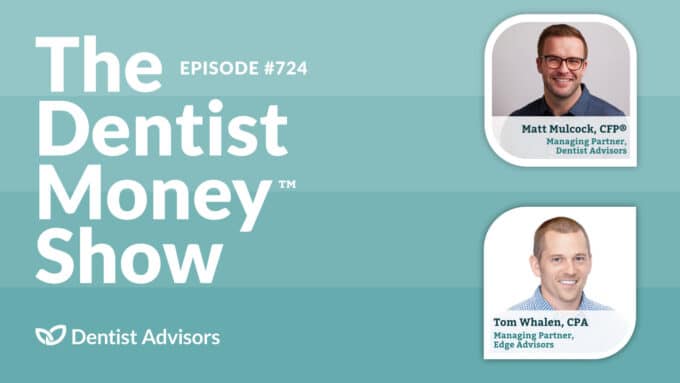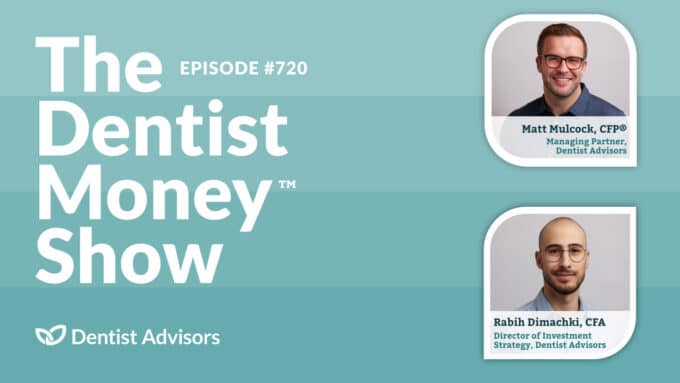Not all methods of saving money are glamorous. Oftentimes it’s the least sexy strategies that are tried and true. Take 401(k) tax credits for instance. I’m a financial advisor and even I don’t get overly excited about 401(k) tax credits. Here’s the thing though – dentists need to know about this because of how much it can save them on taxes. They also need to know about it now because it has to be taken care of before the end of December to count for the current tax year.
At the end of 2022, Congress passed the SECURE Act 2.0 which largely focused on issues related to retirement and savings. The government wanted to incentivize small businesses to contribute to their employees’ retirement accounts by offering a higher tax credit. They increased the tax benefits in three different areas of setting up a retirement plan:
- Costs associated with setting up a retirement plan
- Employer contributions
- Automatic Enrollment Credit
As a dentist, you can’t ignore these tax benefits—especially if you do not already have a retirement plan set up for your practice. Depending on your situation, this could be a significant amount of money left on the table. Note that most of the tax incentives benefit new 401(k) plans. If you already have a retirement plan for your practice, keep reading because there are tax credits that apply to you as well.
(Note: If you don’t know what a tax credit is, here’s a quick explanation. It is a dollar for dollar reduction on your tax bill. Let’s say you have a $20,000 tax bill. A $5,000 tax credit would reduce your tax liability to $15,000. Pretty sweet!)
With that, let’s dive into each category! Stick with me – it’s easier than you think.
Start-up costs
Setting up a retirement plan isn’t cheap. You’ll have administrative fees, advisor fees, documentation setup fees, etc. To lower the barrier to entry, the government is offering $500-$5,000 as a tax credit for the first three years to help offset the cost of setting up a retirement plan.
As with anything the government does, you have to meet their qualifications. You have to be considered an eligible employer with 100 or less employees and you have to incur reasonable expenses when you set up your retirement plan.
Quick definitions you’ll need to know when thinking about 401(k)s.
Eligible Employer:
-
- You have 100 or fewer employees who were paid at least $5,000 in the year prior.
- There has to be at least one person who is not considered “highly compensated”.
- Over the last 3 years before you are eligible, your employee base has not substantially remained the same.(We know this is a weird one. Essentially, the government is targeting newer small businesses who have not set up a retirement plan).
Highly Compensated
-
- Owns more than 5% of the business; or
- Made more than $135,000 in 2022 or $150,000 in 2023
- Was in the top 20% of employees ranked by compensation
Qualified costs
- Any ordinary and necessary expenses needed to set up the retirement plan and educate your employees about the plan.
The tax credit is different for employers with 1-50 employees versus those with 51-100 employees. The government is more generous with smaller businesses. For practices with 50 or fewer employees, 100% of qualified startup costs are considered for the $5,000 tax credit. For practices with 51-100 employees, only 50% of qualified startup costs are considered.
I break down the math for you here:
For employers with 50 or fewer employees, 100% of qualified startup costs are considered for the $5,000 tax credit. This would be the lesser of $5,000 or $250 multiplied by the number of non-Highly Compensated Employees. For example: If you are a practice owner and you have 16 non-HCE, then you’d receive a $4,000 tax credit.
For employers with 51-100 employees, 50% of qualified startup costs are considered for the $5,000 tax credit. In other words, a practice owner under this situation would have to incur $10,000 in start up costs to receive the full $5,000 tax credit.
Employer contributions
If you want even more tax credits, you can contribute to your employee’s retirement accounts. Let’s start with eligibility.
- The employer eligibility requirements are the same as above.
- Eligible employees are those compensated $100,000 or less per year.
The tax credit is based on a percentage of the employer contribution. The maximum is $1,000 per employee per year stretched out over a 5-year period. Similar to the first category, the tax benefits are greater for smaller businesses.
For a practice with 1-50 employees, 100% of employer contributions are eligible for the tax credit for the first two years, 75% in the third year, 50% in the fourth year, and finally 25% in the fifth year.
Here is an example of how this could look:
For example, say a practice has 20 eligible employees and they are each receiving $1,000 in employer contributions each year for 5 years. In the first two years, the tax credit would be $20,000, $15,000 in the third year, $10,000 in the fourth year, and $5,000 in the fifth and final year.
For a practice with 51-100 employees, the structure is similar but the tax credit phases out. The more employees you have, the fewer tax benefits you will receive.
I dive into the math here:
Each additional eligible employee above 50 employees results in a 2% decrease. At 50 employees, 100% of employer contributions are eligible for the tax credit. At 51 employees, 98% of contributions are eligible. At 60 employees, that’s 80%. Going off of that number, let’s say a practice has 60 eligible employees. The tax credit would be $48,000 for the first two years, $36,000 in year 3, $24,000 in year 4, and $12,000 in year 5.
Automatic Enrollment Credit
Last but not least, eligible employers with 100 or fewer employees may claim a $500 tax credit per year for three years by adding an automatic enrollment feature to their retirement plan by 2025. If you already have a retirement plan, this is your chance to get a tax credit for a few years!
If this is information-overload, that’s understandable. Try not to get stuck in analysis-paralysis. The time you spend strategically setting up a retirement plan with your tax professional and financial advisor could result in large tax savings.
Need help setting up a 401(k) for your practice? Get Started Today!





